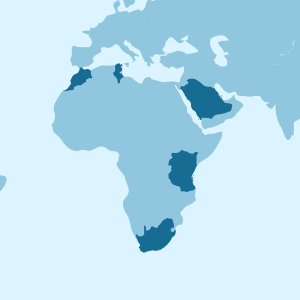Work in the USA: Requirements and opportunities
Do you want to work in the USA? Discover the requirements, types of visas, most in-demand jobs, salaries, and cost of living.
Work in the USA isn’t just a dream for many worldwide — it can become a real opportunity for personal and professional growth. Thanks to its dynamic job market, wide range of industries, and competitive salaries, working in the USA offers stability, challenges, and a different lifestyle.
This guide covers everything you need to know to work in the United States: Advantages, requirements, job types, salaries, cost of living, and where to find real offers. A perfect starting point if you’re ready to take the leap.

Advantages of Working in the United States
Working in the U.S. offers important benefits that can change your personal and professional life:
- High income and professional growth: Salaries, especially in technology, healthcare, and finance, are higher than in many countries. You’ll find environments that support growth and global collaboration.
- Innovative environment and real opportunities: World-class companies like Google, Microsoft, and Amazon are based in the U.S., giving access to cutting-edge projects and constant innovation.
- Diversity and global networking: Working with people from different cultures expands your perspective and builds valuable professional connections.
- Security and legal stability: The U.S. system offers strong labour protection, insurance, and legal rights that create confidence and safety.
- Benefits for foreign employees: Depending on your visa (like J-1 or H-1B), you may receive tax exemptions, social security benefits, and access to quality healthcare.
- High quality of life: Many U.S. cities offer great living standards with access to education, healthcare, leisure, and wellbeing services.
Requirements for Working in the United States
These are the main requirements to work legally in the U.S. They vary depending on your country of origin and visa type:

1. Get the right visa
- H‑1B: For specialized occupations (technology, healthcare, engineering). Requires a university degree or equivalent and employer sponsorship. Up to 65,000 visas plus 20,000 for postgraduates are issued annually.
- H‑2A / H‑2B: For temporary jobs. H‑2A is for agriculture; H‑2B is for non-agricultural jobs (tourism, hospitality, construction).
- E‑2 / E‑1 / E‑3: Investor or treaty-based visas (E‑2, E‑1) and the E‑3 for Australian citizens.
- O‑1: For people with extraordinary ability in science, arts, sports, or business.
- There are also permanent visas (EB‑2, EB‑3, EB‑5…).
2. Employer petition
- In most cases, your future employer in the U.S. must submit a petition (Form I-129) to USCIS. Without it, you can’t apply for the visa.
3. Language level
- You’ll need at least an intermediate English level (B1–B2). Technical and customer-facing roles require fluency in reading, writing, and conversation to pass interviews successfully.
4. Education and experience
- For H-1B and similar visas, you’ll need a professional degree or equivalent experience and proof of eligibility for the role.
- For O-1 visas, you must demonstrate exceptional achievements (awards, publications, or recognitions).
5. Extra certificates and permits
- Some categories (like H-1B) require a certified Labour Condition Application (LCA) approved by the Department of Labour. Regulated jobs such as healthcare, education, or construction might also need state licences.
6. Family permits
- Many visas (H-1B, E-2, O-1, etc.) allow your spouse and children to accompany you on dependent visas (H-4, E-2 dependent, O-3). In some cases, they can also work legally.
7. Previous paperwork
- Usually, a U.S. company must submit a petition to immigration authorities. You may also need a labour certificate or recognition of your degree and work experience.
Tips for Starting Work in the United States
- Plan your arrival carefully: Arrive well-prepared with documents, luggage, and temporary housing arranged. This reduces stress and helps you focus on your first day.
- Get internet from day one: Subscribe to a Holafly monthly plan before you arrive. With an eSIM that offers unlimited data in the U.S., it activates with a QR scan and provides 24/7 support in your language. This allows you to stay connected from the moment you land.
- Research your city’s living costs: Know how much rent, transport, and food will cost. This helps you negotiate better salaries and avoid surprises.
- Optimise your CV for the U.S. market: Use a clear format focused on achievements. Include industry keywords and highlight education and experience.
- Prepare for English interviews: Practise with simulations and small talk. Use short answers and specific examples to build confidence. It will help you gain confidence.
- Start networking early: Use LinkedIn and virtual events to meet contacts. Join professional groups in your field and engage actively.
- Save and plan your first months: Control expenses until your first salary arrives. Keep savings for rent, transport, or emergencies.
- Learn about your labor rights: Familiarize yourself with the labor system: Pay dates, overtime, and benefits. Understanding the system helps you stay informed and protected.
Types of Jobs in the United States for Foreign Workers
When you arrive in the U.S., several job paths open depending on your profile and visa type. Here are the most common roles for foreigners:
Type of Job | Description | Common Visas |
|---|---|---|
| Technology and STEM | Developer, data analyst, engineer. Highly demanded in cities like Seattle or Austin. | H‑1B, O‑1, EB‑2 |
| Healthcare | Nurses, technicians, assistants. High demand with sponsorship options from hospitals. | H‑1B, EB‑3 |
| Hospitality and Services | Waiter, barista, cleaner, receptionist. Common in hotels and restaurants. | H‑2B, J‑1 |
| Construction and Trades | Bricklayer, plumber, electrician. Opportunities in large projects and growing areas. | H‑2B: |
| Agriculture and Rural Work | Crop harvesting and farm maintenance. High-season demand across several states. | H‑2A: |
| Exchange Programmes | Internships, au pair, summer camps. Ideal for students or young workers. | J‑1: |
| Administration and Customer Support | HR, payroll, call centres, and support roles. Some companies offer sponsorship. | H‑1B, E‑3 |
| Entrepreneurship | Start your own business or invest. Work legally for yourself in the U.S. | E‑2, EB‑5 |
Most In-Demand Jobs for Foreigners in the U.S.
If you’re thinking about working in the U.S., you might wonder which roles are most needed. The good news is that several industries consistently require foreign talent. From tech to services, here are the most in-demand jobs:
- Technology (software, AI, data, security): Developers, data scientists, and cybersecurity analysts are highly sought after. In 2025, IT and maths fields filed over 278,000 H-1B applications, with average salaries around $128,500 (€110,500) per year.
- Healthcare (nurses, doctors, medical assistants): Hospitals face shortages of about 130,600 doctors and 260,000 nurses by 2025, leading to sponsorships via H-1B, EB-3, and H-2B programmes.
- Engineering and STEM: Civil, mechanical, and electrical engineers, plus researchers, remain priorities. STEM growth stays strong, and these profiles are preferred for H-1B visas.
- Construction and Skilled Trades: Builders, electricians, and plumbers remain in demand for large projects under H-2B and EB-3 visas.
- Agriculture and Seasonal Work: H-2A farmworkers fill seasonal gaps in harvest and agribusiness.
- Hospitality and Services (waiters, cleaners, cooks): Hotel chains and restaurants need staff for peak seasons. Immigrants make up about a third of the hospitality workforce.
- Green Jobs / Renewable Energy: Wind turbine technicians, solar installers, and environmental specialists are rapidly growing sectors.
Salaries and Cost of Living in the United States
When you think about working in the U.S., an attractive salary sounds great, but you should also consider daily expenses. Here’s how they differ:

Typical Salaries
- The average annual salary in the U.S. is about $63,795 (€54,800), roughly $5,300 (€4,500) gross per month.
- In technology, finance, or healthcare, wages often exceed $100,000 (€86,000) yearly. For instance, software engineers average around $113,720 (€97,700).
- Net monthly salaries usually reach about $4,000 (€3,400), depending on the state and tax system.
Monthly Living Costs
- Living in major cities costs between $2,500 (€2,150) and $4,000 (€3,430) monthly, including rent, food, transport, and utilities.
- In central New York or San Francisco, costs can rise to $5,000–6,000 (€4,300–5,200), mainly due to housing.
- In mid-size or smaller cities such as Houston or Boise, you can live on $1,500–2,000 (€1,250–1,700) a month.
| Your Monthly Salary | Living Costs | Balance |
|---|---|---|
| ~$5,300 gross (€4,550) / ~$4,000 net (€3,430) | $2,500–4,000 in large cities (€2,150–3,400)/ $1,500–2,000 (€1,280-1,700) in smaller ones | You can live comfortably in mid-size areas and even afford big-city life with good pay. |
If you earn over $100,000 (€86,000) yearly (~$8,300 gross / month), you’ll easily afford even the most expensive cities. With an average income, living in affordable regions lets you save and enjoy life comfortably.
Important: If you are a frequent traveler and want to stay connected without worrying about expensive roaming or looking for a new SIM at every destination, Holafly’s subscription plans are for you. With a single eSIM, enjoy internet in more than 160 countries for a fixed price and no surprises on your bill. Travel without limits and connect easily and securely! 🚀🌍

Where to Find Job Opportunities in the United States
- Platforms such as LinkedIn, Indeed, Monster, and Glassdoor are great for jobs offering visa sponsorship. LinkedIn also lets you connect directly with recruiters.
- Websites like MyVisaJobs.com and USponsorMe specialise in listing employers who sponsor H-1B, EB-3, or similar visas.
- If you want seasonal work (tourism, farming, construction), the official SeasonalJobs.dol.gov site from the U.S. Department of Labour lists H-2A and H-2B openings.
- The Summer Work Travel (J-1) programme lets you work and travel for several months through authorised agencies.
- Recruitment companies in the U.S. help international candidates secure jobs and process visas, especially in technical or healthcare fields.
- If you prefer remote work while job-hunting, start freelancing on Upwork, Fiverr, Toptal, FlexJobs, or We Work Remotely.
- NGOs like Upwardly Global support immigrant professionals with mentoring, training, and job access in engineering, healthcare, and administration.
How to work in United States: Requirements and opportunities.
Frequently Asked Questions About Working in the United States
It depends on your background, but there are roles in technology, healthcare, hospitality, farming, construction, customer service, and exchange programmes such as au pair or summer camps.
Average pay is about $5,300 (€4,550) gross monthly. Tech and healthcare roles pay much more, while seasonal jobs match local minimum wages, usually between $1,500 and $2,500 (€1,290 – €2,150).
The H-1B visa allows stays up to six years and has “dual intent,” meaning you can apply for a green card while working.
Yes, at least an intermediate level. Better language skills open more opportunities, especially in customer-facing or technical roles.
In many cases, yes. For example, with an H-1B or E-2 visa, your spouse and children can join you on dependent visas, and your partner can often apply for a work permit.














































 Pay
Pay  Language
Language  Currency
Currency 


















 No results found
No results found









